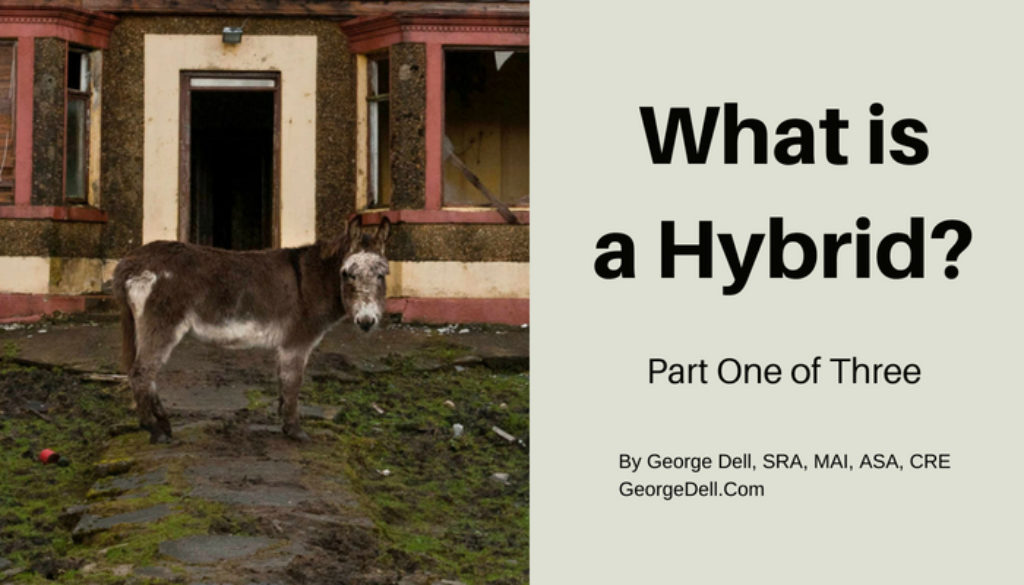A hybrid is: The offspring of two plants or animals of different species or varieties, such as a mule (a hybrid of a donkey and a horse). Per my Google online dictionary . . .
An appraisal hybrid, as I understand it, is two people, doing two parts of the appraisal job. One looks at the property, the other fills in the form. (Don’t worry, we are reassured that USPAP allows us a wide berth on scope of work). In fact, the Scope of Work Rule says:
- “Appraisers have broad flexibility . . .”
Unfortunately, it also says:
- “. . . and significant responsibility . . . in determining the appropriate scope of work for an appraisal or appraisal review assignment.”
It strikes me that the real issue is “who is in charge?” . . . of the decision to rely on the work of the “valuation inspector.” Who is in charge? Who determines the scope of work?
USPAP says “When a signing appraiser has relied on work done by appraisers and others who do not sign the certification, the signing appraiser is responsible for the decision to rely on their work.” Hmmm. So, when a lender, or AMC, or any client selects the real estate agent (a Realtor® is not necessary), we are to believe that the hybrid agent “has no say in value”!
So, are we to believe that the client-assigned “inspecting” agent has no impact on value? Don’t things such as measuring a property size, site size, location, effective age, condition, and appeal – affect value?
USPAP continues: “The signing appraiser is required to have a reasonable basis for believing that those individuals performing the work are competent.” Again, no problem. We have the client’s assurance of the competency of their chosen “no impact” inspector.
USPAP continues: “The signing appraiser also must have no reason to doubt that the work of those individuals is credible.” Again, the ordering client can fully reassure the appraiser that the paid inspector is fully credible.” Or as defined in USPAP: “worthy of belief.”
Fortunately, the inspectors who are “providing significant real property appraisal assistance” but, do not sign the USPAP certification, need not be named, can stay fully no-name anonymous, known only to the client. As “disclosure of their assistance is required … [in Standard 2]” it appears that an appraiser will need to provide a certification which states that there is reliance and belief in the competency of the anonymous inspector selected by the client. No problem. Problem solved. Trust the paying client.
There is only a problem for the appraiser who signs and “accepts full responsibility for the real property elements of the certification, for the real property assignment results, and .…”
Is it possible that once again, appraisers are put into a Catch 22 situation? Sign the certificate. Get the money. And meet the requirement: “The scope of work is acceptable when it meets or exceeds the expectations of parties who are regularly intended users for similar assignments.”
Do what your clients expect. Do what all your peers do. It must be OK. It says so.
Who is the donkey and who is the horse? Jus’ askin.
This is the first of a series on this issue. We will consider the “other side,” – the mule offspring – as well as a path towards a better and more useful valuation product – to truly promote the public trust.
© You are free to share, copy and redistribute, transform, and build upon for any purpose, except for commercial use. Attribution – You must give appropriate credit and may not restrict others. While I wish to help spread the benefits of the copyrighted terms and materials for the benefit of the valuation community, I wish to restrict those who would monetize or misinterpret or misapply the concepts as written. My experience has been that commercial users are the greatest violators of the open-source, creative commons principles of knowledge sharing.
Thus, we request attribution, share-alike, and non-commercial use only.

July 25, 2018 @ 10:33 am
Thought provoking as always George. My belief is that appraisers hold a fiduciary position, we must operate from a position of trust. If your client is not interested in objectivity, then you have the obligation to decline the assignment. The careful review of the assignment conditions is always warranted – maybe even more so for the client using hybrid valuation product as the process is segmented and there is reliance on another party for the “inspection”. It would be incumbent on the appraiser to assess data and information quality before steaming full speed ahead and rendering a value. Hybrids can work in certain conditions to meet “the expectations of parties that are regularly intended users of similar assignments”. It just that we must be prepared to explain in certain circumstances when the client might be better served with another type of valuation product. The value of appraisers today is the bridge of trust between the data and the results.